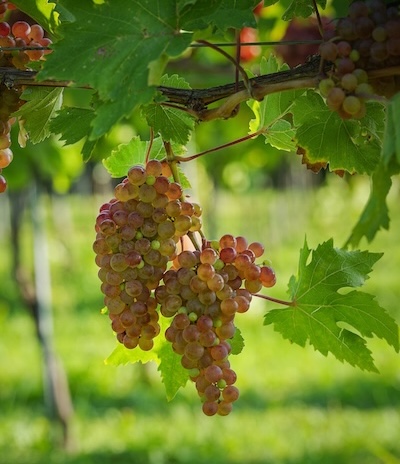 ®
®
RARE GRAPE VARIETAL RESOURCE
Roter Veltliner - Historische Rebsorten / Slow Food (Rotmuskateller, Red Veltliner) RARE GRAPE pink

The Roter Veltliner vine, which is a white wine variety, bears dark pink colored grapes when ripe. The shoot tips are also copper-red, as are the leaf stalks. It has only minimal water and nutrient requirements, making it suitable for dry sites without irrigation, with middle to late ripening (October). The grapes have a high pectin content, the flesh is jelly-like. The wine is flowery, with a distinct acidity and, if properly matured, storable for lengthier periods. The grapes are resistant against light and heat (sunburn). When cultivated organically, this variety is much less sensitive to downy mildew than Grüner Veltliner, but an important factor for the quality is selecting good vine material from clones with loosely packed grapes, because poor clones grow too strongly and are only light red. Among all the vines native to our country, Roter Veltiner is no doubt be labeled the most ‘Austrian’: hardly any other autochthonous vine variety has a historical documentation dating so far back. It was apparently already cultivated in this region even in Roman times. This vine is also documented to be the parent variety of several native wine varieties (Neuburger, Zierfandler, Rotgipfler, Frühroter Veltliner). This reflects the long time that the Roter Veltliner vine has been and continues to be highly valued in our region, especially considering the many other varieties that have long since disappeared. The world of wine has seen many trends come and go and, compared with the cultivation of wine varieties, the memory of wine enthusiasts and wine-growers is very short. A case in point is the relationship between Grüner Veltliner and Roter Veltiner. Today, Grüner Veltliner is clearly more important; in 1895 the situation was reversed. Back then, Roter Veltliner made up an estimated 90% at Wagram and the Krems region, Langenlois, but also in large parts of Lower Austria and other provinces of the Imperial Danube monarchy; it was a very widely distributed vine due to its vinicultural and cellar-technical advantages. The Grüner Veltliner, in contrast, although a pure varietal in this growing region, covers a distinctly smaller surface area. At Wagram the ‘Landwirtschaftliche Casino Fels am Wagram’ (viniculture association) is undertaking great efforts to maintain the varietal identity of the vineyards and to preserve pure Roter Veltliner (vulgo Rothmuskateller), which is highly prized by buyers from the Vienna market. To the north, however, in the so-called Weinviertel, the varietal diversity was higher in the 18th century; ‘Weißmuskateller’ (vulgo Grüner Veltliner) was making advances. The earliest documentation of both varieties in the agrarian literature stems from the mid-16th century, although it remains unclear whether the Roter or the Grüner dominated. The Rothmuskateller is the ancestor of an entire varietal family and can be documented in Austria further back than the written wine-growing documents: the oldest sources are the bills of sale at the Imperial court. In the 18th century, however, the balance increasingly tilted toward Weisser Muskateller. The name Veltliner was first introduced by German viniculturalists in 1840. In the 1960s the variety became less fashionable – intensive agriculture proved to be its undoing – and it gradually lost importance. The old vineyards with their high-quality, loosely packed dark red grapes remain only in western Wagram. In individual vineyards, new selected lines were developed from these old clones in the 1990s. Since then, the stock has slowly begun to grow, and especially the region of Wagram has distinguished itself, motivated by its wine enthusiasts. The name Wagram stems from the word ‘Wogenrain’. Wagram is a region 120 river-kilometers downstream from Linz on the Danube and 70 km upstream from Vienna. It stretches 25 km along the northern Danube banks and, from the Danube (about 180 m above sea level), rises to the north up to about 400 m elevation. The south-sloping, often 20 to 30 m wide deep-soiled loess slopes are ideal for wine-growing, while the flat sites are used for farming. Wagram, with its 2500 ha of vineyards, is one of Austria’s largest wine-growing regions. During the course of the Franconian expansion to the east, cloisters in 12th century southern Germany promoted wine-growing along the Danube. They were able to make wine an export commodity, easily transporting it along the Danube to the northwest. Even today, wine remains the most important economic sector.
(Courtesy of Slow Food Foundation for Biodiversity – Ark of Taste) https://www.fondazioneslowfood.com/en/ark-of-taste-slow-food/?fwp_arca_settore=wines-and-grape-varietals-en)
"The grape variety, also known as "Ariavina" (vine of the Aryans), is not related to the Grüner Veltliner and does not come from Valtellina either! At the moment, as an autochthonous grape variety of the Austrian wine-growing region Wagram , the focus is again on it, but it is of great regional importance for us. Because it loves deep soils, it was widespread in the southern German loess regions. Recognizable by their synonyms "Rosa Orléans von Nierstein", "Traminer near Oppenheim" or "Meat grapes near Worms". The cultivation in our latitudes gives the wine a wonderful, noble aroma when it is appropriately ripe." (https://historische-rebsorten.de/rebsorte/roter-veltliner/)
Help us populate this website. Whatever verifiable information you could provide re: this varietal or others (story pertaining to the varietal, description, producer, importer etc...) would be appreciated.
 Countries grown:
Austria,
Czech Republic,
Hungary,
Slovakia
Countries grown:
Austria,
Czech Republic,
Hungary,
Slovakia